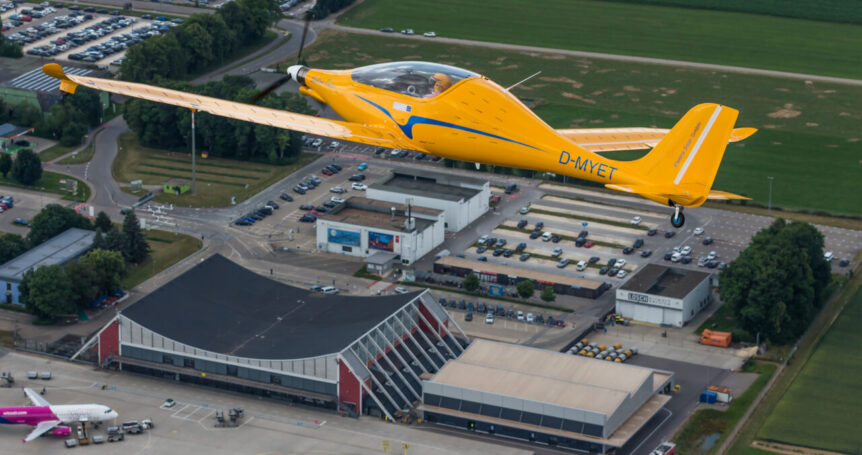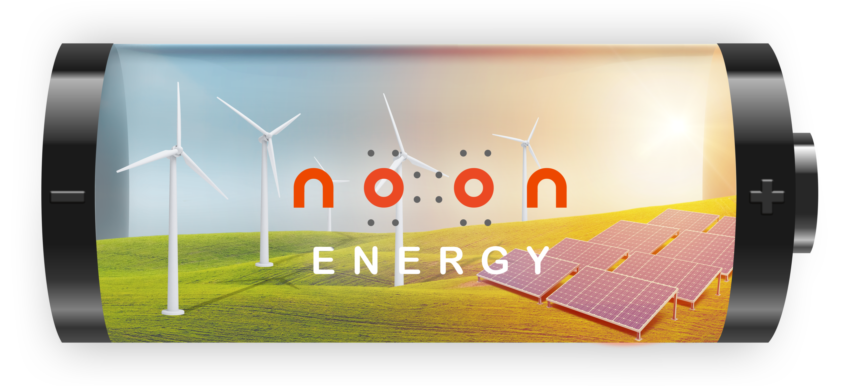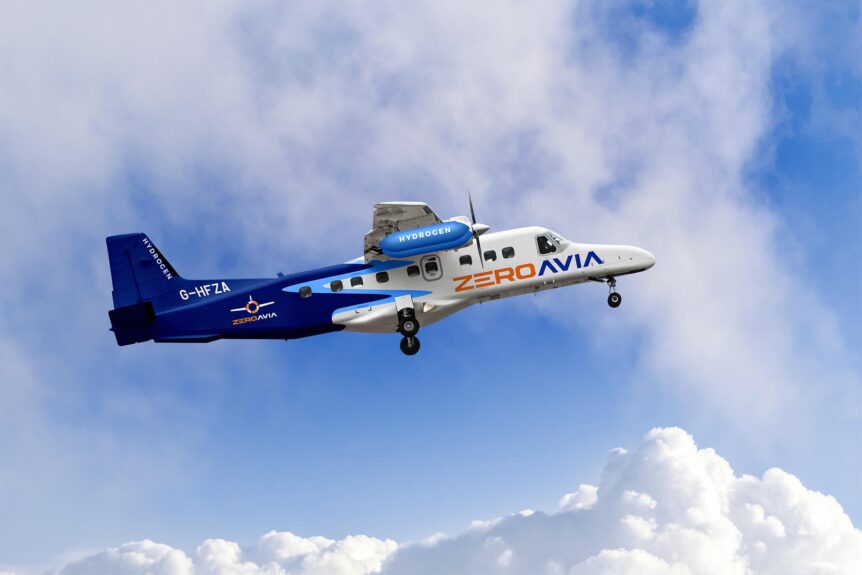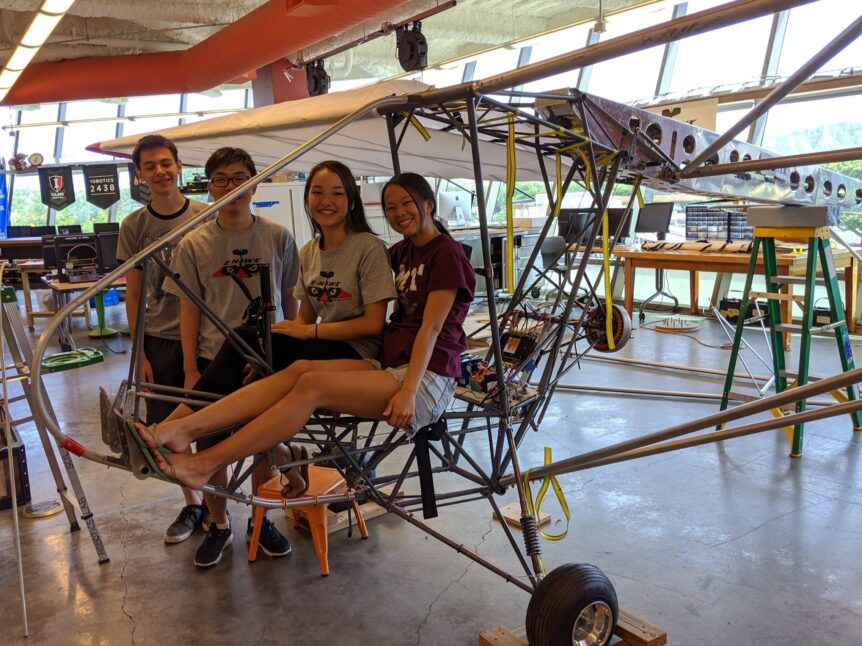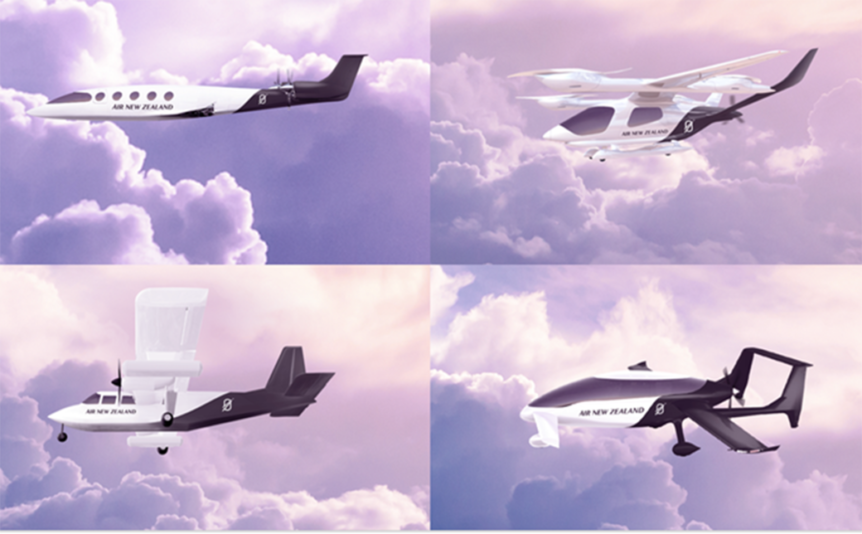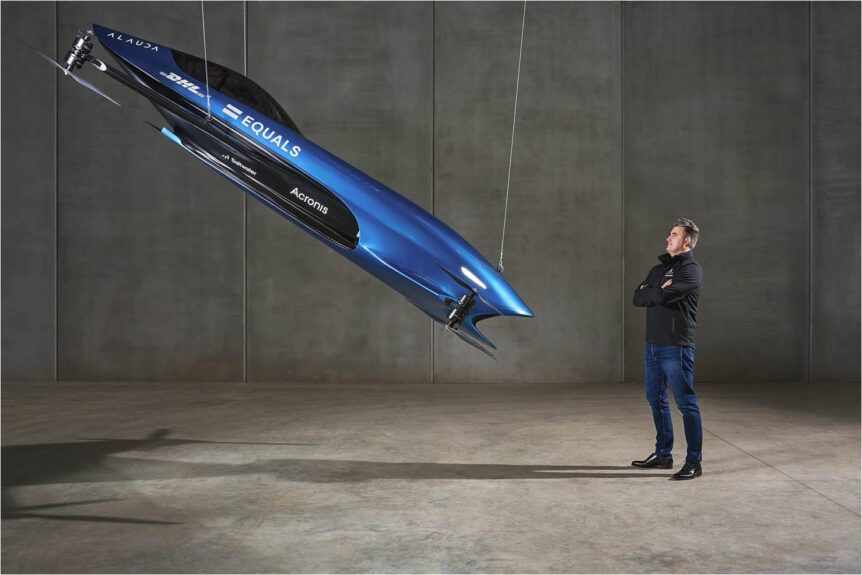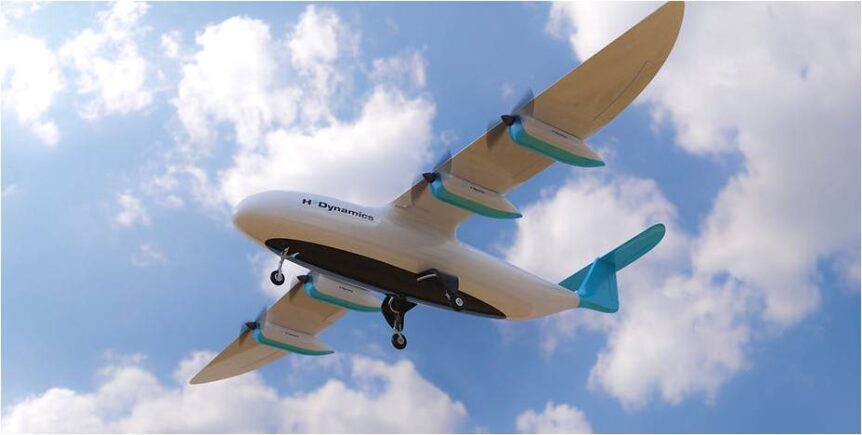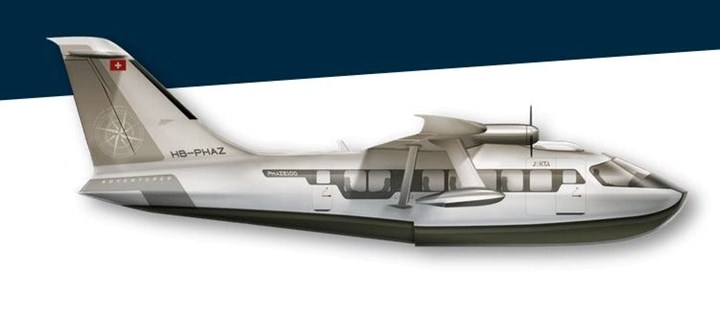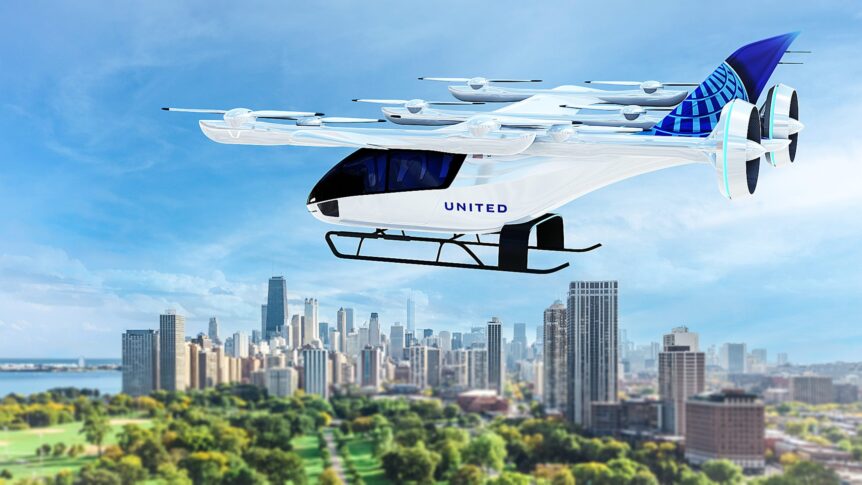Calin Gologan has been in the electric and solar-powered airplane business for a long time. Displaying and flying his Elektra One at Oshkosh, Wisconsin in 2011, he was early to the game. Now, with the his Elektra Trainer certified, relatively inexpensive flight training is imminent. Birgit Weissenbach announced the June 29 maiden flight, subsequent test flying, and January 19, 2023 certification of Elektra Solar’s two-seat, side-by-side trainer. In a 20-minute flight from Memmingen International Airport, taking off in less than 100 meters (328 feet), the craft confirmed “the extraordinary characteristics of the aircraft, which even exceeded the expectations of the developers.” Certification came from DULV (Deutschen Ultraleichtflugverbandes, or German Ultralight Association), as the representative of the Federal Ministry for Digital Affairs and Transport (BMDV). Test pilot Uwe Nortmann reported a climb of eight meters per second (“Rising like a jet” at 1,575 feet per minute) and a low cruising speed on only 10 kilowatts (13.4 horsepower) “without vibrations in the …
Carbon and Oxygen and Dirt Cheap Batteries
Carbon and oxygen comprise a big part of the universe, and are essential to life on earth. They may also be the answer for long-term energy storage in a promising battery development from Noon Energy. “100 hours of storage at one-tenth the cost of lithium-ion batteries for long-duration storage.” It started on Mars According to Electrek, “Chris Graves, Noon Energy’s founder and CEO launched the company in 2018 After helping to develop NASA’s Mars Perseverance rover MOXIE device, which produces oxygen from the Martian carbon dioxide atmosphere.” According to TechCrunch, “The device sucks in carbon dioxide and strips off an oxygen atom, which it stores on board. The remaining carbon monoxide is exhausted into the thin Martian atmosphere. MOXIE, by the way, is an acronym for “Mars Oxygen ISRU Experiment. ISRU is another acronym, In Situ Resource Utilization,” or on-site use of available resources. MOXIE was also the name of an early carbonated soft drink or energy beverage. On Mars, MOXIE …
ZeroAvia Flies Dornier 228 on Left-Wing Hydrogen
Stephen Bridgewater made a quick announcement on ZeroAvia’s Twitter feed Thursday January 19 about a Dornier 228 that flew with a hydrogen-powered motor on its left wing. ZeroAvia continues making the largest-yet H2 flights. ZeroAvia’s 19-seat Do228 flew today (from Kemble) at 13.35 UK time. It’s the largest hydrogen-electric powered aircraft yet to fly (hydrogen-electric engine on left wing and Honeywell TPE-331 on the right). This comes a year after the firm started modifications to the twin-engine Dornier aircraft in both England and California, and a little over two years since it flew a Piper Malibu first on batteries, and then hydrogen. Despite a crash landing that ended the Cranfield, England-based Malibu, ZeroAvia has stuck to its ambitious schedule. Another Piper Malibu continued testing at Hollister, California, part of the company’s efforts toward achieving both English and American certification. Performing engine tests early last years and following up with taxi tests at increasing speeds, ZeroAvia made a 10-minute airport circuit …
Aircore: a Different Approach to Axial Flux
Aircore Mobility’s press release from the Consumer Electronics Show (CES) in Las Vegas headlines, “Sustainable, air core, axial flux, liquid cooled e-mobility motor achieves superior power density and efficiency to extend vehicle range for applications that drive, fly or sail” The company promotes its efficiency, high current density, and economy of manufacturing as prime factors in its success. The printed circuit board (PCB) stator is claimed to be 10 times more reliable than a conventional stator, smaller, and lighter. By replacing the iron core of a conventional motor with a PCB stator, “Mechanical losses are reduced, efficiency is increased and noise and vibration are significantly reduced.” Several stator/rotor combinations can be “stacked” with a single housing to allow greater power outputs. Cooling is an important element in the motor. Aircore uses a liquid cooling technique, “That allows the coolant to be in direct contact with the stator, mitigating heat across a larger surface area, enabling high overload capability and extended …
Aloha from Iolani and E-Hawk
Take a skillful design by an ultralight aircraft expert, add a small but dedicated group of high school students, a versatile advisor, and you end up with an electric aircraft that incorporates cutting edge innovation with a traditional airframe. Iolani High School’s E-Hawk has been flying over Hawaii for the last few months, a reminder of how skilled and talented today’s high schoolers can be. Your editor did an article for Kitplanes magazine about their endeavors, with great help from the students and their advisor, Martin Emde. The most surprising part of that story was how many electronic systems were essentially designed and fabricated by the students. These included battery packs and some fairly sophisticated instrumentation. For instance, this motor monitor is a bespoke device, designed, programmed, and crafted by the students. Some of the readouts from the instrument show up on the right side of the screen in the video below, part of the November 25 flight. Mike Friend, …
Air New Zealand Plans for Zero Emissions
Air New Zealand has a five-part plan for reducing and even eliminating aviation emissions with some well-defined approaches and goals. The airline hopes to achieve net zero by 2050, with demonstrable steps toward that starting now. Five Key Elements ANZ will rely on five key elements in its quest for zero-emission flight. They are already involved in producing sustainable aviation fuel (SAF), partnering with makers of zero emission aircraft technologies, renewing their fleet, reducing carbon emissions through improved flight and ground operations, and removing carbon using best known techniques. You can read the full sustainability report here. Producing SAF Sustainable aviation fuel (SAF), explains Air New Zealand, “Is made from a variety of sustainable resources other than crude oil, such as used cooking oils, landfill waste, forestry waste, carbon captured from the air and green hydrogen. It has the potential to dramatically reduce lifecycle carbon emissions by up to 80 percent or more compared with traditional jet fuel.” Since New …
Electric Air Racing News
Electric Air Racing is a modern take on an age-old idea. Ever since people tamed horses, the idea of comparing their speeds became important. Boats, cars, and aircraft followed the same path. As with horses, the idea that “racing improves the breed” held sway. Now, one Australian company and a major aeronautical organization hope to make air racing a path to the future. Alauda Aeronautics Matt Pearson founded the Airspeeder racing program with the credo, “Competition accelerates progress.” Toward that end, he partnered with Alauda, an Australian firm, to develop a group of high-performance aerial racers. Looking somewhat like the vehicles flown by Luke Skywalker in the Star Wars films, the “flying cars” certainly evoke a performance image. The team recently flew three Airspeeders via remote control with First Person View (FPV) technology helping ground-based pilots control their craft around a Alauda unabashedly uses the term “flying cars,” as in, “Racing to deliver a revolution in personal air mobility so …
H3 Dynamics and Its Hydrogen-Electric Nacelle
H3 Dynamics (formerly HES – Horizon Energy Systems) has flown a small example of its hydrogen-electric nacelle that could power many craft now in the concept phase. H3 headlines its web page with the words, “Dreaming Big,” followed by the premise, “The future of aviation is hydrogen-electric, autonomous, and digital.” Their press release declares, “The future of hydrogen aviation powered by H3 Dynamics’ distributed hydrogen propulsion nacelles has taken flight for the very first time in France.” Hydrogen could be a dream fuel, clean burning and leaving only a little water vapor in its wake. It has a few drawbacks, though. H2 takes up four times the space of gasoline or kerosene for a roughly equivalent amount of energy. In something sizeable like a semi-truck or a seagoing ship, such space requirements can be accommodated. Airplanes need to be streamlined and svelte, so trying to carry enough energy for long ranges and endurance can spoil otherwise beautiful lines. H3 claims its …
Jekta’s Amphibious Commuter Liner
Jekta’s amphibious commuter liner made its debut at the Abu Dhabi Air Expo 2022. The 10-motor amphibious, 19-passsenger craft could become a familiar sight at coastal landings around the world based on initial interest. Deena Kamel, reporting for The National News, revealed PHA-ZE 100, short for Passenger Hydro Aircraft Zero Emissions, is now in its design stage, “with a prototype scheduled for 2026 before entry into market by 2028,” according to Jekta CEO George Alafinov. Intended to transport people in mega-cities and coastal areas “sustainably and affordably,” according to the article, the 19-passenger is a response to a “world population with an appetite to travel safely, cheaply and ecologically.” Mr. Alafinov makes the case for amphibious craft. “The solution is in front of us: Instead of building airports with devastating irreversible environmental impact, we can use nature’s gift of oceans, lakes and rivers to create an affordable transport system using amphibian aviation.” Further making his case, he added, “Today’s seaplane …
Delta and Joby: United and Archer and Eve
Delta and United Airlines are teaming with eVTOL makers Joby, Archer, and Eve – elevating ways to get to and from their airports. The newly-formed alliances will make airline travel a little less tedious and eliminate the often long and sometimes frustrating drives between flights. Delta and Joby Delta Air Lines will invest $60 million in a partnership with Joby Aviation in return for a two-percent stake in Joby and a seat on its board. Joby can receive another $140 million if it meets “certain milestones.” The selling points of convenience and time saving could certainly entice prospective customers. Initially set up as premium services in New York City and Los Angeles, passengers would still rely on automobiles or shuttles to get them from home or office to a heliport (eventually to be a “vertiport”). There, the passenger boards a Joby five-seat tiltrotor aircraft and flies to the airport in around 10 minutes – a huge time saving over ground …

